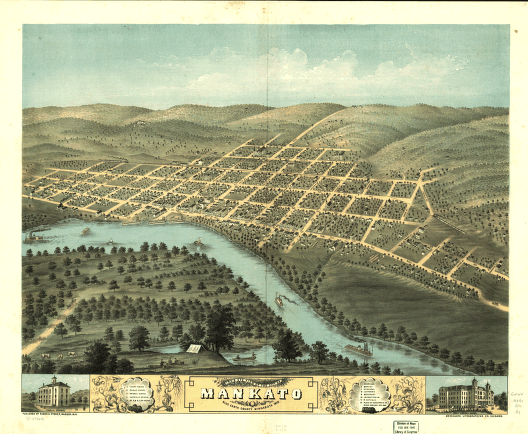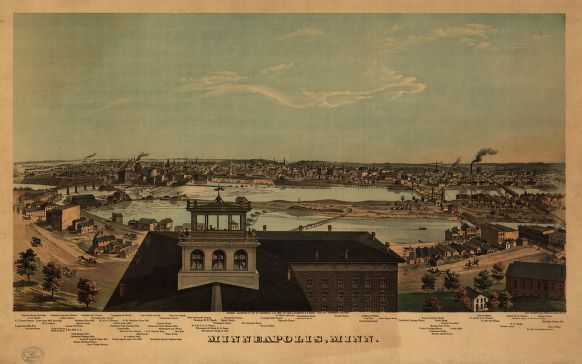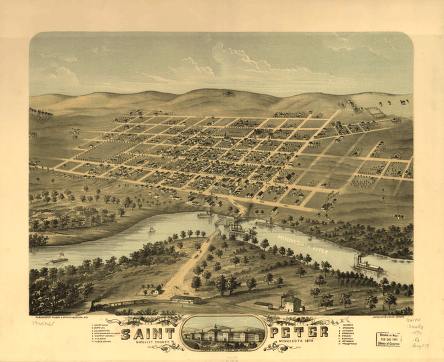
Minnesota Panoramic Maps. The panoramic map was a popular cartographic form used to depict U.S. and Canadian cities and towns during the late nineteenth and early twentieth centuries (1847 to 1929.) Known also as bird's-eye views, perspective maps, and aero views, panoramic maps are nonphotographic representations of cities portrayed as if viewed from above at an oblique angle. Although not generally drawn to scale, they show street patterns, individual buildings, and major landscape features in perspective.

The panoramic map was a popular cartographic form used to depict U.S. and Canadian cities and towns during the late nineteenth and early twentieth centuries (1847 to 1929.) Known also as bird's-eye views, perspective maps, and aero views, panoramic maps are nonphotographic representations of cities portrayed as if viewed from above at an oblique angle. Although not generally drawn to scale, they show street patterns, individual buildings, and major landscape features in perspective.
Panoramic maps graphically depict the vibrant life of a city. Harbors are shown choked with ships, often to the extent of constituting hazards to navigation. Trains speed along railroad tracks, at times on the same roadbed with locomotives and cars headed in the opposite direction. People and horsedrawn carriages fill the streets, and smoke belches from the stacks of industrial plants. Urban and industrial development in post-Civil War America is vividly portrayed in the maps.
Victorian America's panoramic maps are quite remarkable in the perspective of the cities they capture. Most panoramic maps were published independently, not as plates in an atlas or in a descriptive geographical book. Preparation and sale of nineteenth-century panoramas were motivated by civic pride and the desire of the city fathers to encourage commercial growth. Many views were prepared for and endorsed by chambers of commerce and other civic organizations and were used as advertisements of a city's commercial and residential potential. These maps reveal much about the great contrasts and contradictions of the industrial age and the progressive era.
Preparation of panoramic maps involved a vast amount of painstakingly detailed labor. For each project a frame or projection was developed, showing in perspective the pattern of streets. The artist then walked in the street, sketching buildings, trees, and other features to present a complete and accurate landscape as though seen from an elevation of 2,000 to 3,000 feet.
Panoramic maps graphically depict the vibrant life of a city. Harbors are shown choked with ships, often to the extent of constituting hazards to navigation. Trains speed along railroad tracks, at times on the same roadbed with locomotives and cars headed in the opposite direction. People and horsedrawn carriages fill the streets, and smoke belches from the stacks of industrial plants. Urban and industrial development in post-Civil War America is vividly portrayed in the maps.
Here is a complete list of the city maps included in this collection. Where you see a city listed several times, there are several different maps - either maps created in different years and/or by different map making companies.
| 1. Anoka 1869 2. Appleton / Granite Falls / Montevideo / Preston 1874 3. Austin 1870 4. Brainerd 1914 5. Duluth 1883 6. Duluth 1887 7. Faribault 1869 8. Hastings 1867 9. Lake City 1867 10. Luverne 1883 11. Mankato 1870 12. Minneapolis / Saint Anthony (Hennepin County) 1867 13. Minneapolis 1873 14. Minneapolis 1874 15. Minneapolis 1879 16. Minneapolis 1885 17. Minneapolis 1891 18. Minneapolis 1891 19. New Ulm 1870 |
20. Northfield 1869 21. Owatonna 1870 22. Red Wing 1868 23. Red Wing 1880 24. Rochester 1869 25. Saint Cloud 1869 26. Saint Paul 1853 27. Saint Paul 1867 28. Saint Paul 1873 29. Saint Paul 1874 30. Saint Paul 1883 31. Saint Paul 1888, 1887 32. Saint Paul 1893 33. Saint Paul 1906 34. Saint Peter 1870 35. Shakopee 1869 36. Stillwater 1870 37. Winona County 1867 38. Winona 1867 39. Winona 1874 40. Winona 1889 |
Each map image on this CD is a super high resolution scan of an original panoramic map. Original maps were often as large as 36" x 36" or even larger. To offer all these maps at 100% detail, they are stored in either MRSid format or in JPEG 2000 format and require special viewers to be able to view all the details in these superb historical maps. Viewers and full viewing instructions for Windows computer platforms are included on this CD.



Below you will find an example of the enlargement ability of the maps contained on this CD. You will see how you can view a small snapshot of the image all the way up to an incredible level of detail at the highest resolutions. The below set of images comes from Mystic CT and gives an excellent example of the level of detail in these maps at various levels of "magnification".

(Smallest size of this image)

(Small portion enlarged 2 times)

(Small portion enlarged 3 times)

(Small portion enlarged 4 times)

(Small portion enlarged 5 times - this enlargement represents the full
original size of the map when printed at full scale.)
As you can see from the above images, each map offers hours of exploration and excitement as you explore the cities as they were 100 or more years ago.
These maps may be viewed on your computer or printed out. The software will allow you to size the maps to any level of detail you wish and either print out the entire map or just a portion of it. (Even full scale maps can be printed with a large enough printer - like the ones used in your neighborhood poster and print shops.)
To use this software, you must install the free Map Viewing software which is included on the CD. This is a 30 second process and will allow you to view and manipulate/print all the maps in this CD collection in full detail. There are versions for Windows platforms and full installation instructions are included on the CD.